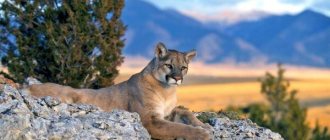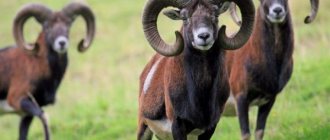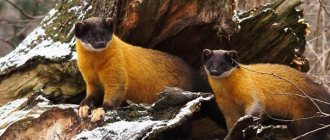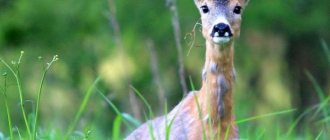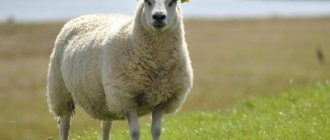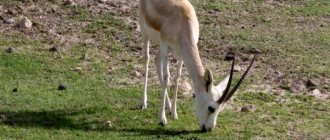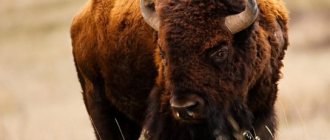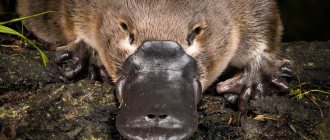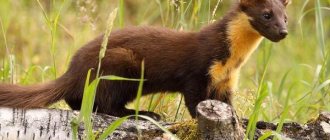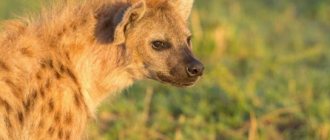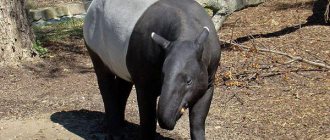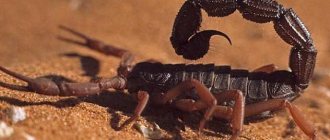Just the sight of an elk evokes a feeling of admiration in a person. A few centuries ago, moose were worshiped, so images of this animal are found in the sarcophagi of ancient burials, as well as in the dwellings of primitive people, such as caves. Moose have always represented strength and endurance. People simply call them “stalkers,” since the shape of the horns bears some resemblance to ancient agricultural tools.
The scientific name “elk” comes from the Old Church Slavonic language and meant “ols”. This concept was associated with the red color of the fur of moose calves. Siberians simply called the animal “beast”. The North American Indians were distrustful of this “beast,” so they retold the legend of the treacherous moose, but the Canadian Indians considered this “beast” a noble animal. In the city of Vyborg there is a monument to an elk, who at the cost of his life saved the lives of hunters who got lost.
How much does a moose weigh?
The artiodactyl is rightfully considered the largest representative of the deer. The height at the withers reaches more than 2 m 30 cm, and the length of its body is 3 m. Few forest dwellers can boast of such “external characteristics”. How much does an adult moose weigh with such an impressive size? In answering this question, it is impossible to name a single figure that can be used as a guide. A young moose weighs about 300 kg, and large adult representatives can exceed the 800 kg mark. On average, weight ranges around 500-600 kg, but females weigh less than males. An elegant moose can weigh only 200 kg in her body.
Taken from wikipedia.com
Social structure and reproduction
Photo: Wild elk
These large ungulates live alone or gather in groups of up to 4 individuals. Females form a herd of up to eight heads; in winter, young bulls can graze with them. With the onset of spring, the animals disperse. In the summer, moose cows walk with calves, sometimes with last year's calves. Some pairs remain after the rut, sometimes they are joined by last year’s calves and adults, forming groups of 6-9 animals. After the rut, males often live separately, and young ones organize small groups. In winter, the herd population increases, especially during the snowy seasons.
It happens that artiodactyls gather in pairs before the start of the rut, at the end of summer. The bull begins to make mooing sounds as he follows the female into heat. At this time, males begin to break off branches and tops of trees with their horns and beat them with their hoofs. Where a moose cow has urinated, they eat the soil and leave a characteristic smell everywhere. At this time, the bulls eat little, their fur is disheveled, and their eyes are bloodshot. They lose caution, become aggressive, and drive away elk calves. The rut can last for a month; it begins earlier in the southern regions, in the north - later, from mid-September. This difference is due to the onset of late spring in the north - a time more favorable for the birth of babies.
During the rut, bulls are usually monogamous. But if the female moose does not respond to courtship, then the male looks for another one. Near the female you can meet several contenders and there are fights between them, often with fatal results. Young moose are ready to mate in the second year, but do not participate in the rut before the age of four, as they cannot compete with adult bulls. Young people enter the mass race later than the “old people.” Pregnancy lasts from 225 to 240 days, one to two calves are born, weighing 6-15 kg, depending on gender and quantity. The color of elk calves is light brown with red. The second cub often dies. After 10 minutes, newborns are already on their feet, but immediately fall.
On the second day they move unsteadily, on the third they are already walking well, and by the fifth day they are running, and after ten days they are even swimming. At first, the cub is in one place, but if the mother runs away, it lies hidden in the grass or under a bush. The female feeds the calf with milk for about four months, until the rut. In individuals that do not participate in mating, lactation continues. From two weeks old, moose calves begin to eat green food. By September they gain weight up to 150 kg.
Moose speed
The chest of the artiodactyl is powerful, and the shoulder girdle is equally powerful. The legs are quite long, moderately thick, but with narrow hooves. This suggests that moose run well and are not forest bumpkins at all. The speed of an elk can reach 70 km/h, so when asked who runs faster, an elk or a deer, the primacy can be given to the elk. But the speed of a deer develops only up to 55 km/h. If we compare who covers the distance faster, a lion or an elk, then the elk loses. Eagles are also excellent swimmers - if necessary, they can swim up to 20 km continuously, but deer cannot boast of this.
The animal's fur is quite coarse, but the undercoat is soft. The animal prepares thoroughly for winter - its fur lengthens by about 10 cm, which prevents it from freezing in winter. The hair on the neck and withers is longer, so it appears as if there is a mane. The color of the elk is very interesting - in appearance it looks almost black, the brown color of its fur is so rich. In the lower part of the body, in the abdomen area, you can see a light brown color, which creates a beautiful ombre. The elk's legs have characteristic white “socks”. In the summer, the animal becomes darker, but by winter the coat becomes a little lighter.
Here is a visual video of a moose running across a field:
Behavior of yearlings
The moose can hardly be called an aggressive animal; in case of danger, it will prefer to hide than to attack. They can reach speeds of up to 56 km/h and swim very well. Therefore, they can hide from the enemy freely. Moose can attack during the rut, but young moose at this time will also prefer to hide. If the danger comes, for example, from a bear, then an adult elk can fight off in an open area, and therefore bears choose to attack places where there are bushes, and the victim will have nowhere to turn around for protection.
Elk is a herbivore that feeds on pine needles, fir, rowan, aspen, birch, and raspberries. In the summer they prefer water lilies, marigolds, and watchwort, and in the fall they switch to twig food. It does not matter when food intake occurs: at night or during the day, and therefore it is difficult to call these representatives of ungulates nocturnal, diurnal or crepuscular animals.
Due to the low aggressiveness of moose, farmers in the USSR attempted to domesticate them, but this did not justify the costs. To keep these animals in captivity, special conditions must be created, and this requires effort and money. Although elk can produce fairly high-fat milk (8-13%), the meat, which is used for sausages and canned foods, still requires a lot of effort to raise.
Horns
The biggest pride of a moose is its antlers. It was because of them that he became prey for humans. Even in ancient times, elk antlers in the house were considered the main prey of a hunter; they were a symbol of dexterity and good luck in hunting. The weight of such horns can reach an average of 20 kg and this is not surprising, because their span is almost two meters.
The base of the horns is a short trunk and a spade-shaped branch on which 18 branches are located. The elk's horns are individual. The size and location of the processes are distinguishing features between animals. Usually the adult representative has the most massive and heaviest shoots, but a small moose can boast of its horns only after its first birthday. Initially they are soft, the base is covered with thin skin and short, delicate fur.
During this period, young individuals suffer from insect bites as they bite through the horns, reaching the blood vessels running inside. After about a year or so, the horns harden so much that active blood circulation in the tissues stops. From this moment on, the horns grow in width, and after five years the width of the shovel will be significantly larger than the shoots. At this age, the horns of a young individual become similar in shape to the horns of an adult.
Author: Alexander Chester
Age names
First of all, in order not to get confused in terms, you need to know what moose are called based on their age:
- Elk 1 year old - young of the year.
- About 1.5 - one and a half year old elk.
- 2 years or more – adult.
- After 10 years - old.
In addition, the hunters’ habit of calling a male elk a bull, a young elk a calf, and a female a cow will be interesting for a beginner. In terms of body structure, they are indeed somewhat similar, but the elk has a more elongated body, thin legs and antlers. Therefore, you should not be surprised if among the scientific literature there are references to bulls when talking about moose.
Why is it important to know how old a moose is? Because there are different hunting periods: according to the decree of the Russian Federation of January 10, 2009, hunting for sexually mature individuals is allowed from November 1 to December 31, in some areas - from October. In this case, individuals under 1 year of age should make up 20% of the entire population, which means that it is necessary to correctly determine whether the elk is a yearling or an adult. It is not so easy to confuse age groups; even by appearance you can determine which group a given animal belongs to.
Why does a moose shed its antlers?
Usually by the onset of winter the animal sheds its antlers. This is an absolutely painless procedure that brings him relief. To free itself from its antlers, the elk actively rubs them against trees, after which the antlers fall off. In the spring it grows new antlers, which harden in July. By the way, only males have horns, while females are deprived of such decoration.
"The moose has shed its antlers." Author: Theresa Holiday
"Abandoned elk antlers." Author: William Jacobson
There is an opinion that antlers are needed to protect the elk in the forest from other animals, but this is not true. The main purpose of the horns is to attract a female during the mating season and protect her from other males. As the mating season passes, the horns become unnecessary. Shedding antlers for winter makes wintering much easier - it is easier for the animal to move around and find shelter.
The immediate cause of the loss of horns is a decrease in the amount of sex hormones produced in the animal’s body. As a result of hormone deficiency, special cells are activated at the base of the horns that can have a destructive effect on bone tissue. It is thanks to their work that the horns weaken significantly and then disappear altogether. The elk's horns become an important food source for forest animals - squirrels, birds and predatory animals eat the protein, which is contained in abundance in the horns.
Determining age from footprints
From the tracks you can find out not only the age of the elk, but also its gender. So, in a young male the ends of the hooves are ground down, and in the female they are pointed, but in older individuals the opposite is true. To see the differences in the tracks, you need to take into account the correct track left in river valleys or in the ground. Moss, marshy areas, snow - the wrong surfaces. The snow melts, softening the features of the trail, and the moss gradually levels out. Therefore, prints on them should be compared with marks on a more stable surface.
Thus, observing individuals in a certain area will allow you to notice the difference between the size of the female and male tracks. You will also see the difference between a yearling, a one and a half year old elk, an adult and an old one. By the age of 10, the tracks, like the antlers, begin to become smaller and sharper, whereas the rest of the time they were large and round. In addition, you can track a specific elk by following its tracks: a characteristic notch, a recognizable scratch, an unusual shape of a hoof - there are no absolutely identical tracks.
Where does moose live?
Moose live mainly in the Northern Hemisphere. Previously, European countries allowed the shooting of moose, so a century and a half ago there were practically no moose left. Environmental laws have been adopted in Russia, thanks to which the moose population has been preserved. However, isolated cases of poaching still occur.
Modern Europe also acquired these animals, and they were brought to the north. Moose now live in Belarus, Norway, Finland, Ukraine, Poland, and Hungary. The Baltic countries can also boast of elk. The artiodactyl feels at ease in Russia - its distribution area extends from the Kola Peninsula to the steppe zone in the south. The elk is widespread in both Canada and the United States of America.
Animals love cool coniferous forests, where there is marshy soil, rivulets or streams. They feel best in the forest-tundra because there is a lot of different trees. Routine does not suit the animal, so the elk will look for diverse greenery.
Artiodactyls do not move very actively - they look for food near their permanent habitat, and if the area is rich in food, then the elk can stay in such an area for a long time. Since they love medium-sized and low-growing bushes, they suffer from a lack of food in winter. Sometimes the height of the snow cover exceeds 70 cm, which is unacceptable for those places where groups of moose live. This forces the moose to look for a new place to live. The animal cannot get food in such a layer of snow. In this case, animals migrate to places with less snow cover, and in the spring they return to their usual habitat. A group of moose is quite grouped; in winter they try not to wander far from each other, but in spring they show more independence.
Author: Pamela Fletcher
Natural enemies
Recommended by topic
Muskrat Flying squirrel Chameleon
In their natural environment, moose do not have many enemies. Only bears, a pack of wolves, a lynx or a wolverine can cope with the mighty artiodactyl. But even in this case, the predator will have to show considerable intelligence. Moose flee for their lives, but if cornered by predators, they use their antlers and sharp front hooves.
A driven elk rests its croup against a natural shelter (tree, rock or bush) and puts its antlers forward. Predators in this situation try to avoid direct contact, since a blow from a hoof can break the skull of an adult bear. Therefore, predators leave dangerous prey and look for other food.
Mostly, old, sick or young animals become prey for predators. Sometimes bears attack pregnant females or drive an adult moose into deep snow or windfall. If a giant gets stuck in the snow or cannot turn around in front of the predator, then he has practically no chance of fighting off.
During the hunt, wolves try to fight off weak individuals from the herd. The pack then chases the animal until it runs out of strength. During the chase, predators bite the elk's hind legs, trying to tear the tendons or draw blood. The giant weakens, falls and becomes easy prey.
But the most dangerous predator at all times has been and remains man. The uncontrolled hunt for horned giants almost led to disaster. The extinction was stopped, but the population of artiodactyls is still under vigilant control, although it has left the risk zone.
What does a moose eat, what does it eat?
To chew food, the elk has eight large and powerful incisors located on the lower jaw. All elk eat is plants, so the animal's teeth are designed for prolonged grinding. Also, six molars and the same number of small molars are involved in the chewing process.
What does an elk eat when living in the forest - of course, pasture plants. Among the animal's preferences are grasses, shrubs, moss, mushrooms, and lichens. Among the trees, elk prefer to eat the succulent leaves of rowan, birch, maple and ash. If there are swamps in the area where the animal usually lives, then the artiodactyl will happily feast on plants growing near water. The elk loves marsh water lily, marigold, and egg pods. When young sedge arrives, animals are happy to include it in their diet.
Author: Stefania Backer
Among herbs, elk prefer fireweed, fireweed, and sorrel. The diet includes lingonberries and blueberries, and in the fall, moose also add tree bark. If an animal loves succulent plants so much, what does a moose eat when autumn and winter come? As soon as the leaves begin to dry and fall off, the elk actively eat the branches. At this time, you can see a lot of bitten bushes in the forest - this is the work of moose. In winter, moose eat tree bark and shrubs - pine, forest raspberry, rowan or fir. All that the elk eats at this time is rather meager and monotonous food. You can get lichen and tree debris from under the snow in winter. The food that elk eat can reach about 35 kg per day in the summer, but in winter it is three times less. During the winter season, moose drink very little water.
Interesting fact
Moose are true salty food lovers. They can eat soil enriched with salt, lick stones, and drink salt water. Moose also eat fly agarics without fear. With the help of these mushrooms, they expel intestinal parasites from the body.
Moose eat mainly in the morning and late evening. In the middle of the day they lie down in places where they are not bothered by blood-sucking insects.
Features of character and lifestyle
Photo: Elk in summer
Sokhaty is not very smart; when frightened, he always goes ahead in a straight line. In ordinary life he prefers well-trodden paths. Forest giants avoid areas where the snow is deeper than 70 cm and collect on shady slopes, where the layer is looser. The load on the snow is too great and the artiodactyl falls through, although its long legs help it overcome snow-covered areas. Young elk calves follow the tracks of the adult on such cover.
During feeding, the animal stands; when eating food from the surface of the ground, it tries to spread its legs wide and kneel down; small moose calves often crawl while doing this. In case of danger, the animal relies more on its hearing and sense of smell; it sees very poorly and does not notice a motionless person. Moose do not attack people, only in exceptional cases, when they are injured or protecting their cubs.
During the rut, mammals are constantly active. In the cold season they rest up to five times a day, but with heavy snow or at the end of winter up to eight times. At low temperatures, they plunge into the snow, from under which only their heads are visible, and lie for long hours. During strong winds, forest giants hide in thickets. In the 1930s, elk were raised on special farms for use in military operations, and they even attached machine guns to their antlers. They were taught to distinguish Finnish speech from Russian by ear and to give a sign. Animals picked up a person's voice at a distance of more than a kilometer.
In early June, elk are active during the day. With the rise in temperature and the appearance of a large number of horse flies and horseflies, artiodactyls tend to cool, where the breeze blows and there are fewer insects. They can nest in young conifers, in open marshy areas, shallows, and along the banks of reservoirs. In shallow waters, animals lie down in the water, in deeper places they go into it up to their necks. Where there are no bodies of water, the giants lie down in a damp place, but as soon as it warms up, they get up and look for a new one.
Not only does the midge force them to lie down, but high temperatures are poorly tolerated by these artiodactyls, so in the summer they prefer daytime rest.
Lifespan
Moose live for about 25 years, but in their natural habitat their life expectancy is about 10 years. Some moose die from predators living in the forest and various diseases. Other animals die at the hands of humans. Winter is an alarming time - many animals die during the movement of ice, and babies do not survive the harsh cold.
Author: Sarah Blare
Author: Richard Hardman
Posted by Kimberly Mason
Is hunting of one-year-old animals allowed?
Legislation establishes a certain percentage of the elk population that can be shot. Thus, there is a license for shooting adult moose and shooting “calves”. In this case, the skills of how to find out the age of a moose by various signs will come in handy, because the mistaken shooting of an animal of the wrong age category is fraught with an administrative fine. For citizens, such an oversight threatens with deprivation of hunting tools, a fine of 1000-2000 rubles and deprivation of the right to hunt for up to two years, and for officials - sanctions of 10,000-15,000 rubles and confiscation of weapons.
Despite the permission of hunting, there is a question of conscience: is it necessary to hunt young of the year, which are actually moose calves, weak and often not surviving the cold season? Many people give up hunting this age group. However, using the same logic, another thing will also be true: many of the fingerlings will not survive the winter, so why not shoot the weak ones? There is such a dependence: if a female gave birth to and raised one elk calf this year, then next year she will give birth to 2, and then 3. Therefore, the shooting of young of the year is carried out in order to regulate and stimulate the number of elk in a given area.
Nevertheless, if a hunter does not want to kill a young-of-the-year elk, then he can hunt only adult individuals, taking into account the norms established by law, the availability of a license and the timing of the hunt.
What is the difference between elk and deer?
Very often deer and elk are confused. And this is not surprising, because the descriptions of the animals are similar, and only an experienced person will see the differences. Both animals represent the artiodactyl order and the deer family. Of course, belonging to the same classification group ensures similarity between these animals, but there are still significant differences. For example, elk has the largest weight among deer, but deer weigh three times less.
Another fact that distinguishes elk from its relative, deer, is its antlers. Elk also boasts longer legs, which deer do not have. The structure of animal horns is also different - the direction of growth and the shape of the branches. It can also be noted that a deer and its female can have antlers, but only males have antlers on elk.
Number
The moose population can be seriously threatened by poaching, since the value is provided by antlers used for trophies, meat used for canned food and sausages, hides for dressing and milk suitable for medicinal nutrition. Because of this, it is important that every hunter has an understanding of the yearling elk population in nearby areas, knows the hunting periods, and has a license. In addition, wolves, grizzly bears and brown bears are reducing the number of moose. It is practically not dangerous for adults to deal with wolves, but young, old and sick animals are destroyed by them.
Diseases also do not allow these animals to live long. Particularly dangerous are ticks and nematodes that affect the nervous system. Up to 15% of adult individuals die in a year, but young of the year may not survive the first winter with a 50% probability. This is facilitated by harsh environmental conditions, predators and other factors. Therefore, the issue of shooting young of the year is being actively discussed among hunters. In addition, frequent deaths of moose include death under the wheels of cars. Since drivers often fail to avoid a collision, they themselves often die from this accident.
